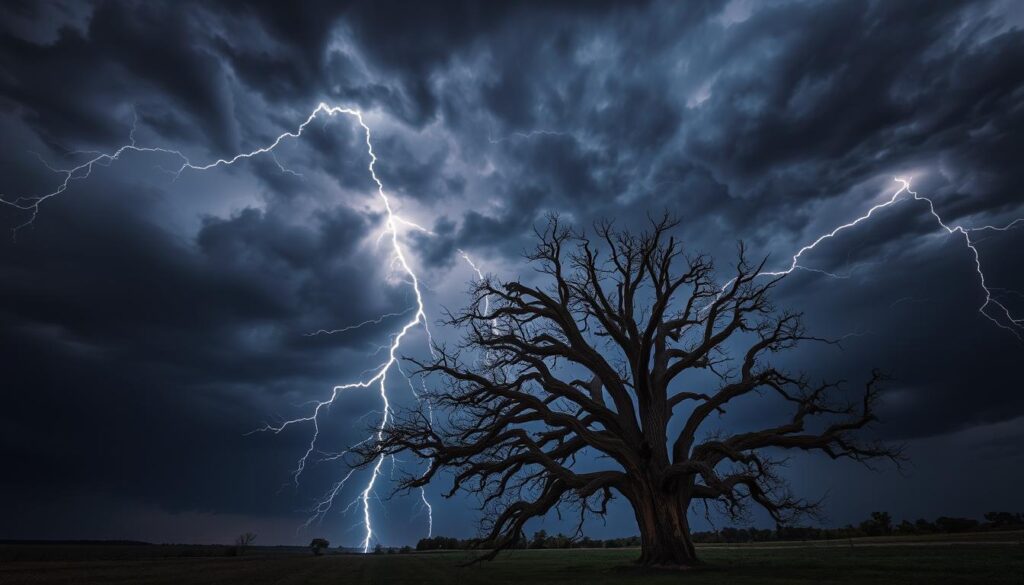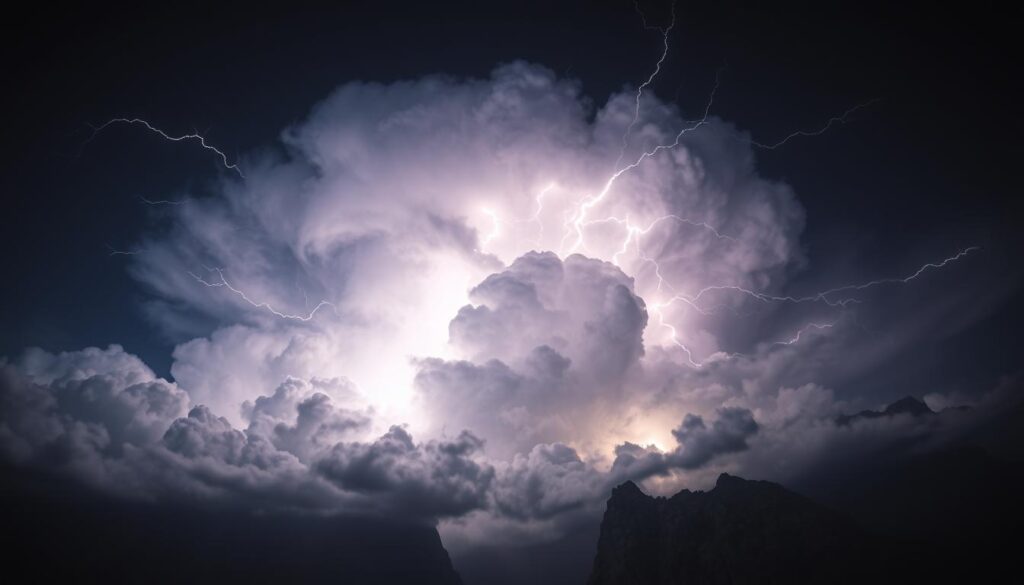The Catatumbo lightning storm is a breathtaking natural wonder. It draws visitors from all over the world. This storm lasts 10 hours every night, creating a never-ending light show.

The lightning storm in Catatumbo is truly awe-inspiring. It lasts 10 hours every night, making it a natural wonder. This light show is a result of the perfect mix of geography and weather, offering an unforgettable experience.
Key Takeaways
- The Catatumbo lightning storm is a natural phenomenon that occurs for 10 hours every night.
- This lightning storm is located in Catatumbo and is a popular tourist destination.
- The storm is a result of the unique combination of geographic features and weather patterns.
- It is considered nature’s eternal light show due to its duration and frequency.
- The lightning storm in Catatumbo is a must-see for anyone interested in witnessing the power of nature.
- The storm attracts visitors from around the world and is a unique experience.
- The combination of lightning storm and geographic features makes it a breathtaking display of nature’s power.
Understanding the Phenomenon: When Lightning Storm Lasts 10 Hours Every Night
The lightning storm phenomenon is a stunning display of nature’s power. It’s important to understand its causes to fully appreciate it. A scientific explanation shows that it’s often connected to unique geographic features like mountains, valleys, and coastlines.
Several factors contribute to the lightning storm phenomenon:
- Atmospheric conditions: Warm air, moisture, and wind shear create the perfect storm environment.
- Topography: The land’s shape and elevation can make warm air rise, cool, and condense, forming clouds and rain.
- Climate patterns: The movement of high and low-pressure systems, and weather fronts, affect lightning storm frequency and intensity.
By looking into these factors, we can better understand the scientific explanation of the lightning storm phenomenon. We see how geographic features shape our weather.
The History Behind Nature’s Greatest Light Show
The history of lightning storms is truly captivating. For centuries, people have been amazed by these natural wonders. They are often called nature’s greatest light show.
Indigenous communities were among the first to notice lightning storms. They saw it as a spiritual event. As time went on, the storm’s history evolved with the people and their environment.
- Indigenous communities have been observing the storm for centuries
- The storm has been a source of inspiration for artists and writers
- Scientific studies have shed light on the causes and effects of the storm
Nowadays, the lightning storm draws tourists from all over. They come to see nature’s greatest light show. Knowing the history of this event makes it even more special.
Location and Geographic Features That Create This Marvel
The location of the lightning storm is key to its creation. The mix of geographic features and atmospheric conditions in this area is perfect. Warm air from the equator and cool air from the poles meet here, creating a storm.
The location has unique topography, with mountains and valleys. These features channel winds, focusing them and boosting the storm’s power. The area’s large bodies of water and coastline shape the storm’s path.
Factors Contributing to the Storm’s Formation
- Unique combination of warm and cool air masses
- Channeling effect of the topography
- Precipitation patterns and moisture levels
- Regional climate patterns and wind currents
The storm’s creation is a complex process. Understanding the location and geographic features helps us see how it works.
Best Times to Witness the Lightning Storm
The best times to see the lightning storm are from June to September. This period offers clear skies and less cloud cover. It’s key to plan and arrive early to catch the storm.
Safety is crucial when watching the lightning storm. Knowing the risks and following local advice is important. Some great times to see the storm include:
- Early morning, just before sunrise
- Late evening, just after sunset
- During periods of high humidity and instability in the atmosphere
These times are perfect for seeing the storm. With the right planning, you can have a memorable experience.

Don’t forget to bring a camera and binoculars to capture the moment. With the right gear, you can take home amazing memories. Seeing a lightning storm is awe-inspiring and unforgettable.
Understanding the Science of Lightning Formation
Lightning formation is a complex and fascinating phenomenon. It has captivated scientists and researchers for centuries. At its core, it’s a product of science and the interaction of various atmospheric conditions. The development of an electrical charge is key, as it creates the conditions for a lightning bolt to occur.
When we explore lightning formation, we see it involves ice and water movement in storm clouds. This movement generates static electricity. It eventually builds up into a powerful electrical charge.
- Storm cloud formation and development
- The role of ice and water in generating static electricity
- The movement of charged particles within the cloud
These factors are crucial for the development of an electrical charge and the formation of a lightning bolt. By understanding the science behind lightning, we can appreciate nature’s awe-inspiring power.
Impact on Local Environment and Ecosystem
The lightning storm’s impact on the local environment and ecosystem is a big worry. The frequent lightning can start wildfires, harming plants and animals. Yet, lightning also shapes the landscape and keeps the ecosystem healthy.
The storm’s effects on the environment and ecosystem are mixed. Lightning can help plants grow back and new ones sprout. But, it can also damage the soil and upset the ecosystem’s balance.
Some main effects of the lightning storm include:
- Changes in soil quality and composition
- Impact on local wildlife and vegetation
- Potential for wildfires and forest fires

In summary, the lightning storm’s impact is complex. While it has negative sides, it’s also vital for the ecosystem’s health. Understanding this helps us see why we must protect our environment.
Photography Tips for Capturing the Storm
To capture the breathtaking beauty of a lightning storm, you need the right photography skills and equipment. Start by using a tripod and setting your camera to manual mode. Adjust the shutter speed to around 1-2 seconds. This will freeze the moment and create a stunning visual effect.
For lightning photography, finding the right location is key. Look for a spot with a clear view of the storm. Make sure you’re at a safe distance from the lightning. Hills, mountains, or areas with minimal light pollution are great spots.
- Use a wide-angle lens to capture the storm’s vastness
- Set your camera to continuous shooting mode to increase your chances of capturing a lightning strike
- Be patient and prepared to wait for the perfect shot
Always prioritize your safety while photographing a lightning storm. Never take unnecessary risks. Be aware of your surroundings at all times. With the right skills, equipment, and precautions, you can capture breathtaking photography that will leave a lasting impression.
Safety Measures for Storm Viewing
When watching storms, safety is key. Risks from lightning and other dangers are real. Using a lightning detector is a smart move to stay safe.
Having a plan for emergencies is also vital. Know where storm shelters are and have a way to call for help. Keep up with weather forecasts and any warnings.
Here are more safety tips for storm watching: * Keep 10 feet away from metal objects or power lines * Avoid open areas like fields or beaches * Stay away from windows and doors. Find shelter in an interior room or hallway * Unplug electronics to protect them from power surges
By following these tips, you can enjoy storm watching safely. Always put safety first for yourself and others. Never risk your safety during severe weather.
Cultural Significance and Local Legends
For centuries, the lightning storm has captivated people. Indigenous peoples have a deep understanding of its cultural significance. The storm’s power and beauty are told in local legends, passed down through generations.
The storm’s impact goes beyond its natural wonder. It shapes the local community’s identity. Many residents feel a strong connection to it. The local legends reflect the indigenous peoples‘ long history in the area.
- Its role in shaping the local landscape and ecosystem
- Its impact on the local community and their way of life
- Its significance in the spiritual and cultural practices of indigenous peoples
The storm’s cultural significance shows its lasting power and beauty. It’s crucial in the lives of those who live nearby. By learning about and respecting local legends and indigenous peoples views, we can truly appreciate this natural wonder.
Tourism and Accessibility Information
Want to see the 10-hour lightning storm? The area has many tourism options and details on getting around. You can choose from cozy inns to eco-friendly resorts, fitting all budgets and tastes. There’s also easy-to-use transportation info, like public transit and guided tours.
The local tourism board makes sure the storm is open to visitors while protecting the environment. Guided tours by experts help you understand the storm’s science and culture. This way, you can dive deep into this natural wonder.
Whether you’re chasing storms or visiting for the first time, the area focuses on green tourism. You’ll see the lightning storm’s amazing display and learn to love nature’s power and beauty.
FAQ
What is the incredible 10-hour lightning storm in Catatumbo?
The Catatumbo lightning storm is a natural wonder in Venezuela. It happens in the Catatumbo river basin. Lightning flashes for up to 10 hours every night.
How often does the Catatumbo lightning storm occur?
This storm happens almost every night for 10 hours. It’s one of the most reliable lightning displays worldwide.
What causes the Catatumbo lightning storm?
It’s caused by unique geography, weather, and atmosphere. Warm, humid air meets cool winds from the Andes. The Maracaibo Basin’s shape adds to the mix.
When is the best time to witness the Catatumbo lightning storm?
The best time is between June and October. The weather is perfect then. Visitors can see the storm almost every night for 10 hours.
What are the safety precautions for viewing the Catatumbo lightning storm?
Seeing the storm is exciting but risky. Visitors should use lightning detectors and seek shelter. Avoiding high-risk areas is also key.
How can I capture the Catatumbo lightning storm on camera?
To capture it, use long exposure times and a tripod. A camera with manual controls is best. Choose a safe spot and know about lightning safety.
What is the cultural significance of the Catatumbo lightning storm?
It’s deeply meaningful to local communities. They have legends and beliefs about it. It’s also a source of pride and attracts tourists worldwide.
What are the accommodation and transportation options for visiting the Catatumbo lightning storm?
There are many places to stay, from hotels to eco-lodges. Getting there is easy by car, bus, or boat. Guided tours help visitors enjoy the experience.
